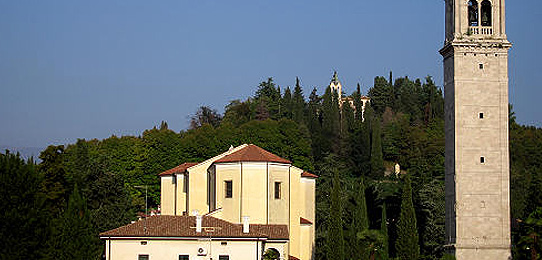You are here: HOME >> PLACES AND REGIONS >> CARD
Places and regions / S. Bona Abbey / Vidor
The great War

Outline of the place:
The Santa Bona Abbey, built by the Benedictines in the XII century, is enclosed between the gravel of the river and the first steep hills of Vidor. The abbey complex is composed of the church, the cloister, the dwellings and a large garden, all of which is enclosed behind a boundary wall.
Located on the front line, the abbey was subjected to heavy shelling by both the Italians and the allies, much the same as that suffered by all of the urban settlements located on the front line, and which resulted in a number of valuable buildings being compromised. The structure can be visited from outside: visits to the interior areas must be agreed upon with those that live there.
Not to be missed:
Valdobbiadene / Bombed centre.
Open to the south and therefore in full view of the allied artillery, the centre of Valdobbiadene was devastated by Italian artillery to stop the adversary troops from finding shelter or removing material useful for fortifications (wood, beams, doors and balconies).
Rebuilt after the war, it was reconstructed with farsightedness and a stylistic balance, and is today known for the extremely famous “Prosecco” wine.
Combai / Strada de la Fam. (starvation road).
Employed as workers by the occupying troops, the women and children of the valley only had a limited food supply (a daily ration of soup) in exchange for many hours of daily work spent building cobbled streets. A large section of the roads necessary for the imperial army was realized in this way and has kept its popular name as “starvation road”.
Follina / Abbey.
The historical monument was hit by a number of cannon shots that destroyed the roof and caused part of the eastern section of the church to collapse. The refectory, built in the XIII century was destroyed to recover wood and in the period following the war was transformed into the oratory-cum war memorial.
Follina / A.U. cemetery
Located behind the civil cemetery, it holds the remains of up to 900 soldiers, 491 of whom are named. Considered as definitively no longer in use with the transfer of the remains to the Austro-German cemetery of Quero, it has recently been the object of restoration projects by volunteers from all over Europe.
Cison di Valmarino / Brandolini Castle.
Dominating the Valsana and in perfect harmony with the historical district of Cison, Brandolini Castle became the residence of officials and a military hospital for the injured from the front. A narrow gauge of the railway tract transported ammunition and materials from Vittorio Veneto towards Pieve di Soligo, passing at the foot of the hills on which the castle stands.
The Santa Bona Abbey, built by the Benedictines in the XII century, is enclosed between the gravel of the river and the first steep hills of Vidor. The abbey complex is composed of the church, the cloister, the dwellings and a large garden, all of which is enclosed behind a boundary wall.
Located on the front line, the abbey was subjected to heavy shelling by both the Italians and the allies, much the same as that suffered by all of the urban settlements located on the front line, and which resulted in a number of valuable buildings being compromised. The structure can be visited from outside: visits to the interior areas must be agreed upon with those that live there.
Not to be missed:
Valdobbiadene / Bombed centre.
Open to the south and therefore in full view of the allied artillery, the centre of Valdobbiadene was devastated by Italian artillery to stop the adversary troops from finding shelter or removing material useful for fortifications (wood, beams, doors and balconies).
Rebuilt after the war, it was reconstructed with farsightedness and a stylistic balance, and is today known for the extremely famous “Prosecco” wine.
Combai / Strada de la Fam. (starvation road).
Employed as workers by the occupying troops, the women and children of the valley only had a limited food supply (a daily ration of soup) in exchange for many hours of daily work spent building cobbled streets. A large section of the roads necessary for the imperial army was realized in this way and has kept its popular name as “starvation road”.
Follina / Abbey.
The historical monument was hit by a number of cannon shots that destroyed the roof and caused part of the eastern section of the church to collapse. The refectory, built in the XIII century was destroyed to recover wood and in the period following the war was transformed into the oratory-cum war memorial.
Follina / A.U. cemetery
Located behind the civil cemetery, it holds the remains of up to 900 soldiers, 491 of whom are named. Considered as definitively no longer in use with the transfer of the remains to the Austro-German cemetery of Quero, it has recently been the object of restoration projects by volunteers from all over Europe.
Cison di Valmarino / Brandolini Castle.
Dominating the Valsana and in perfect harmony with the historical district of Cison, Brandolini Castle became the residence of officials and a military hospital for the injured from the front. A narrow gauge of the railway tract transported ammunition and materials from Vittorio Veneto towards Pieve di Soligo, passing at the foot of the hills on which the castle stands.
Copyright 2010 - Regione del Veneto - Site Map



 top
top info
info print
print